The Cultural Significance of the Turkish Bath
The Turkish Bath, or Hammam, is much more than a bathing ritual—it is a deeply rooted cultural experience that blends hygiene, relaxation, and socialization. Understanding the traditions and etiquette associated with a Hammam helps visitors appreciate its role in Turkish heritage. These baths have long served as places of spiritual cleansing and communal gathering, and following the proper etiquette ensures respect for both the space and its cultural importance.
What to Expect Before Entering the Hammam
Before stepping into a Turkish Bath, it’s important to prepare properly. Guests should arrive on time, stay hydrated, and wear light, comfortable clothing. Most Hammams provide essentials like towels, slippers, and sometimes disposable underwear. Upon arrival, staff will guide you through the steps, but showing courtesy and patience goes a long way. Understanding the flow of the experience before entering helps you feel confident and respectful throughout your visit.
Dress Code and Modesty Norms
In a traditional Turkish Bath, modesty is observed but not in a restrictive way. Men and women usually bathe in separate sections or during scheduled hours. Guests typically wear a peştemal, a traditional cotton towel wrapped around the body. It’s important to respect the privacy and comfort of others by minimizing exposure and avoiding excessive staring or interaction. Being mindful of cultural expectations allows everyone to feel at ease during the session.
Behavior and Silence Inside the Hammam
While a Turkish Bath can be social, maintaining a calm and respectful environment is key. Loud conversations, phone usage, or disruptive behavior are strongly discouraged. The Hammam is a place for rest and reflection, and many guests use this time for quiet meditation or personal renewal. Speaking in low tones, respecting personal space, and embracing the peaceful atmosphere reflect proper etiquette.
Respect for Staff and Rituals
Attendants in a Turkish Bath play an essential role in guiding guests through the bathing process. Their responsibilities include exfoliating, massaging, and ensuring your comfort. It’s important to show gratitude, follow instructions, and trust their expertise. Asking questions is acceptable, but it’s best to remain polite and avoid unnecessary demands. Proper behavior toward staff fosters a sense of mutual respect and helps preserve the integrity of the tradition.
Sharing the Space with Other Guests
Since a Turkish Bath is often a shared experience, observing common courtesies with fellow guests is essential. Avoid occupying shared benches or areas for too long, keep noise to a minimum, and never use another guest’s towel or belongings. Maintaining hygiene, respecting personal boundaries, and creating a welcoming environment help everyone enjoy the Hammam together. The goal is to cultivate a space of harmony and cooperation.
Post-Bath Etiquette and Tipping
After completing your Turkish Bath session, it’s customary to rest in a cooling area and hydrate. Taking your time during this transition helps your body adjust and enhances the benefits of the treatment. Before leaving, expressing appreciation to your attendant with a tip is both traditional and expected. A small gesture of gratitude acknowledges the personal care and skill involved in your Hammam experience and maintains the etiquette of generosity.
Conclusion
Experiencing a traditional Turkish Bath is more than a wellness activity—it’s a journey into a rich cultural practice built on centuries of respect, ritual, and hospitality. Understanding the etiquette not only ensures a smoother experience for you but also honors the legacy of the Hammam. From entering quietly to tipping graciously, each step reflects the values of dignity and mindfulness. Embracing these customs allows you to fully immerse in the beauty, peace, and communal spirit of the Turkish Bath.
Frequently Asked Questions
- Do I need to bring my own towel to a Turkish Bath?
- Most Hammams provide towels, but bringing your own is welcome if you prefer personal items.
- Is it okay to talk during the Hammam experience?
- Quiet conversation is acceptable, but loud talking or phone use is discouraged.
- What should I wear inside the Hammam?
- You’ll wear a peştemal, and many places offer disposable underwear for additional modesty.
- Are phones allowed inside the Hammam?
- No, phones are usually not permitted to maintain privacy and a peaceful atmosphere.
- Is it appropriate to tip the attendants?
- Yes, tipping is a common and appreciated way to thank the staff for their service.
- Can couples bathe together?
- Some modern Hammams offer private rooms for couples, but traditional ones are gender-separated.
- Should I shower before the Hammam session?
- It’s not required, as the attendants will guide the entire cleansing process.
- Is nudity allowed in the Hammam?
- No, modesty is respected, and covering with a towel is standard etiquette.
- How do I know what to do during my visit?
- Staff will guide you step-by-step, so follow their instructions and don’t hesitate to ask questions.
- What is the most important rule to follow?
- Maintain respect—for the staff, other guests, and the tradition of the Hammam itself.
